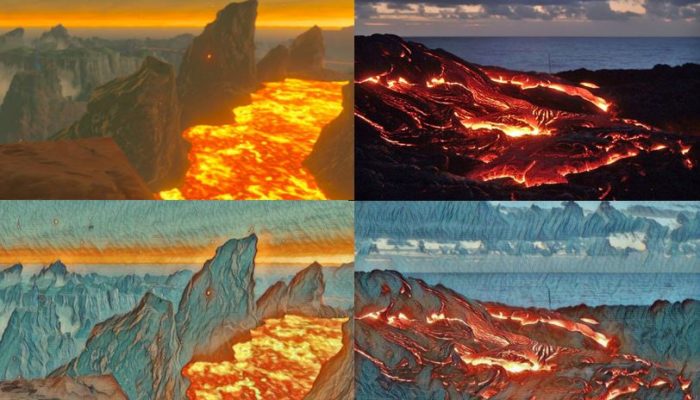
For years, geoscientists have been both fascinated and perplexed by the beautiful (yet often inaccurate) landscapes present in several video games. But are people with a geoscientific education better at telling ‘fake’ natural features from real ones? Rolf Hut, an assistant professor at Delft University of Technology in the Netherlands, and his colleagues sought to answer this question in a new study published in EGU’s open access journal Geoscience Communication.
“Oh wow, that is a gorgeous volcano… which could never exist in the real world.” As a hydrologist I’m not an expert on volcanoes compared to some other EGU members I know. Yet, while walking through the fictional world of Hyrule in Nintendo’s latest installment of The Legend of Zelda game series: Breath of the Wild my emotions tend to constantly switch between excitement at the beauty of the landscape and puzzlement at the geoscientific… wrongness of it.
“That mountain could never generate enough runoff to feed a waterfall this big.”
“Ice capped mountains in the background of a sweltering dessert looks amazing. But it only takes me five minutes to get up that mountain, so there could never be snow there…”
I know: it is just a game. First and foremost game designers had to make this game interesting to play and it wouldn’t have been much fun if you had to walk up a mountain for three days, (Edmund Hillary style) only to find a single piece of in-game equipment . So they condensed the game world. They made decisions that might hurt the sensitivities of geoscientists, but which ultimately made the game more enjoyable (and beautiful) for the majority of those people whose wallets Nintendo is targeting.
This whole process got me wondering: if I hadn’t been trained as a geoscientist, would I have had the same “this cannot exist in the real world” feelings that I now have? Would non-geoscientists interpret this fake world as something that potentially could exist? Given how many people play video games, versus how many are trained as geoscientists, this is an important research question. If people do ‘learn’ from games like The Legend of Zelda: Breath of the Wild, they might get a wrong impression of how the (geoscientific) world works.
Curiosity sparked, we set out to test this. And I say ‘we’ because this type of research requires the expertise of a statistician: Casper Albers, an expert of games for geoscience: Chris Skinner, an expert on science communication: Sam Illingworth, and finally someone who has spent more hours in the fictional world of Hyrule (where the The Legend of Zelda: Breath of the Wild is set) than is in any way reasonable: me.
We picked screenshots from across Hyrule with geoscientifically interesting features such as volcanoes, glaciers, etc. Through a reverse image search (on Google) we then looked for real world photos with matching features. We wanted to ask both geoscientists and those without a geoscientific education to rate those pictures on “how likely they think that the features in the picture can exist in the real world?”. We wanted people to focus on the geo-features, and yet we assumed that normal photos would likely be instantly recognisable compared to the rendered images from the game world; so in order to account for this we applied an artistic ‘van Gogh’ filter to all images.
Two images used in the survey. Panels (a) and (b) are original and (c) and (d) are processed through the “van Gogh” filter. The left two images are from the video game The Legend of Zelda: Breath of the Wild and the right two images are from the real world. The bottom two figures were presented in the survey with the question “Knowing that this picture has gone through a “van Gogh”-filter, how likely do you think it is that the features depicted in the artistic renderings could exist in the real world?”. A 10-point scale was used, where 1 = completely unlikely to 10 = completely likely. (Credit: Rolf Hut et al. 2019)
We distributed our survey among geoscientists and non-geoscientists through social media channels and at the EGU General Assembly 2018. We found two very interesting results. Firstly, it (luckily) transpires that geoscientists are better than non-geoscientists at recognising what is a ‘fake’ landscape from a game; the difference between geoscientists and non-geoscientists is statistically significant. However, the effect is very small and both groups are fairly good in recognising which landscapes are and which aren’t from the game.
What this research therefore highlights is that everyone, including myself, can continue to explore the beautiful countryside of Hyrule, without fearing that we will pick up erroneous knowledge about geoscience.
Of course we have to be careful with interpreting our results: it is only a first study into this new field of science and we encourage anyone to build on our work by studying different games, different screenshots and people across more dimensions than only geoscientists versus non-geoscientist. Our paper is available for free via the open access EGU journal Geoscience Communication, and any questions can be directed to the corresponding author: me. Although please allow some time before I answer: chances are I am not continuously looking at my inbox because I’m spending my time wandering through the beautiful, but recognisably fake, plains, mountains and volcanoes of Hyrule.
By dr. ir. Rolf Hut, researcher at Delft University of Technology, the Netherlands
[This article is cross-posted on Rolf Hut’s personal site]




